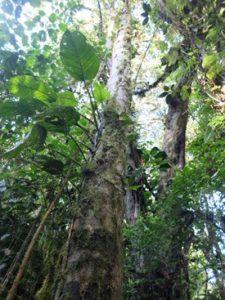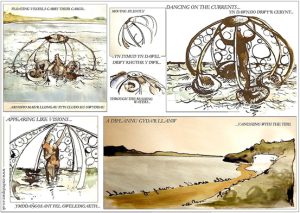73
Katherine Jones, University of the West of England; Tom Payne, University of Aberystwyth, and Owain Jones, Bath Spa University, UK
[brief explanation of Hydrocitizens and how it relates to the Hydrocitizenship project] Hydrocitizens currently has 36 members and is averaging over 500 page visits a day. We are keen to foster and engage in conversations and exchanges about water and related issues with others that are already engaged in the field. Our hope is that we will not only produce a substantial record of our activities and discussions over the course of the next three years, but that others that are not directly involved in Hydrocitizenship might promote their work and engage in debates, making the community their own and enriching our research and their own.
Hydrocitizens is a product of Hydrocitizenship but does not aim to provide a unified authorial voice for the project. Instead, it hopes to do the following:
- Provide a platform through which multiple voices might be heard.
- Create a space in which others might share their work in the hope that unexpected conversations and collaborations might occur. This community hopes to help draw attention to the work of others whilst also revealing the day to day processes behind a large interdisciplinary research project (Hydrocitizenship).
- Provide a way of linking up the four Hydrocitizenship case study areas (Yorkshire, mid Wales, Bristol and the Lee Valley, UK). The community has already led to collaborative ways of working, with ideas from various case study areas feeding into planning processes elsewhere. As time goes by this could prove to be an innovative framework for geographically dispersed interdisciplinary research.
- Create a legacy for the project that exists independently beyond Hydrocitizenship. It is hoped that members will configure the community through the nature of their participation and that it will take on a life of its own.
Here is a selection of some of the many blog entries on Hydrocitizens.
1. Messing About in Boats by Stephen Bottoms
Re-reading Grant Kester’s introduction to Conversation Pieces: Community and Communication in Modern Art (2004) recently, I was struck by his opening anecdote about a spring boat trip on Lake Zurich in 1994:
“Seated around a table in the main cabin were an unusual gathering of politicians, journalists, sex workers and activists from the city of Zurich. They had been brought together by the Austrian arts collective WochenKlausur as part of an ‘intervention’ in drug policy. Their task was simple: to have a conversation. . . . Over the course of six weeks, WochenKlausur organised dozens of floating dialogues . . . Many of the participants in these boat talks would normally have taken opposite sides in the highly charged debate over drug use and prostitution, attacking and counter-attacking with statistics and moral invective. But in the ritualistic context of an art event . . . they were able to communicate outside the rhetorical demands of their official status. Even more remarkably, they were able to reach a consensus supporting a modest but concrete response to the problem…” (pp.2-3)
What strikes me here is how unquestioningly Kester credits “the ritualistic context of an art event” with breaking down barriers — without ever considering the perhaps more obviously apparent fact of being on a boat on a lake… Although this is in no way to underplay the importance of an arts group as instigators to the initiative (thinking creatively, outside the box) I’m guessing that, if asked, the various participants might have spoken more readily of their floating context than of their conceptual framing.
2. An Andean Aqua-culture: Reflecting on the sacred landscape of the Yumbo by Maggie Roe
 If you want to feel what it’s like to be immersed in a water culture, visit a cloudforest like Tulipe where the clouds swirl around you and eveything is dripping. Tulipe is high in the Ecuadorian Andes. It is an extraordinary and beautiful landscape which was manipulated by the Yumbo people to reflect their spiritual connection with the world through water. The Yumbos were an ancient civilization of peaceful agriculturalists and traders who carried goods up and down the mountains to the coast via narrow sunken tracks (culuncos) reminiscent of ancient hollow roads, created so that the vegetation would grow across the top of the routes to act as a cooling and shading green roof. The site I visited at Tulipe was the main sacred gathering site. In an area of flat land next to the river appear large pools, or piscinas. The walls of the pools are made of stone of approximately 1m in depth. Over 2000 mounds of various sizes have also been found in this area. The central piscina area is enclosed by four large flat-topped mounds or tolas (approx. 20m/65ft ht) set at the cardinal points of the compass. On first sight the tolas do not appear to be manmade because the pools seem to nestle amongst them naturally. Some tolas have steps and associated terracing and are thought to have had ceremonial functions. The Tsachilas have flood myths which indicate that tolas were also used as refuges and dwellings and thus become “icons of danger, salvation and sanctity” (Lippi & Gudino, 2010 p.270).
If you want to feel what it’s like to be immersed in a water culture, visit a cloudforest like Tulipe where the clouds swirl around you and eveything is dripping. Tulipe is high in the Ecuadorian Andes. It is an extraordinary and beautiful landscape which was manipulated by the Yumbo people to reflect their spiritual connection with the world through water. The Yumbos were an ancient civilization of peaceful agriculturalists and traders who carried goods up and down the mountains to the coast via narrow sunken tracks (culuncos) reminiscent of ancient hollow roads, created so that the vegetation would grow across the top of the routes to act as a cooling and shading green roof. The site I visited at Tulipe was the main sacred gathering site. In an area of flat land next to the river appear large pools, or piscinas. The walls of the pools are made of stone of approximately 1m in depth. Over 2000 mounds of various sizes have also been found in this area. The central piscina area is enclosed by four large flat-topped mounds or tolas (approx. 20m/65ft ht) set at the cardinal points of the compass. On first sight the tolas do not appear to be manmade because the pools seem to nestle amongst them naturally. Some tolas have steps and associated terracing and are thought to have had ceremonial functions. The Tsachilas have flood myths which indicate that tolas were also used as refuges and dwellings and thus become “icons of danger, salvation and sanctity” (Lippi & Gudino, 2010 p.270).
3. Urchin by Jenny Hall (artist)
The Urchins have grown from an experimental seed developed by a collective of skilled artists, sailors, and makers in the Dyfi Valley in Mid Wales. This collective of free range individuals are working in association with and as Craftedspace, a mid-Wales based design practice that creates art and architecture, making space for laughter and connection.
Initially conceived at ‘Estuary Lab’ in the Dyfi in 2012, funded by the National Theatre of Wales, the original Urchin was built as a simple prototype to explore and dance on the currents and to venture overland, inviting shelter inside its skeletal structure.
Keen to build on the beauty of the form, two urchins were constructed as a prototype and released to an audience at Festival No.6 at Portmeirion village in September 2014. Over a few days we explored the dynamics of and the Urchin’s place within the landscape.
With its striking form, and great potential for development of narrative, movement and structure, collectively we sensed a bigger journey afoot. With this in mind we have been approaching partners in both Wales and Scotland to initiate the creation of a final piece.
A journey over land and water, a tribe of primordial urchins drift, collect, connect, seek sanctuary. A journey that starts with their creation in the Dyfi Valley in 2015, moving up to Scotland, before returning back to Wales to the Eisteddfod in 2016.
References
Lippi, R.D. & Godino, A.M. (2010) ‘Inkas and Yumbos at Palmitopamba in Northwestern Ecuador’, in Malpass, M.A. & S. Alconini, S. (Eds.) Distant Provinces in the Inka Empire: Toward a Deeper Understanding of Inka Imperialism (Iowa: University of Iowa Press).
Author Biographies
Katherine Jones is a geographer with an interest in human-environment relations, alternative living (ecological communities/eco-villages), governance and the everyday politics of human behaviour and choices. She recently completed a PhD focused on the Lammas eco-village in Wales, and the impact of grassroots political community action on planning policy and practice. She is currently a researcher at the University of the West of England on the Towards Hydrocitizenship project, focusing on human-water relationships in the context of Bristol. Contact email: Katherine12.Jones@uwe.ac.uk
Tom Payne is a performer, musician, filmmaker, facilitator, teacher, researcher and freelance digital strategy consultant. He is interested in artistic collaboration, socially engaged arts projects, running workshops, delivering training and providing advice about web strategy development. His practice as research PhD focused on the National Theatre Wales and new and innovative methods of understanding and performing location to produce an alternative theatrical mappings of Wales. He is currently a researcher on the Borth-based case study of the Towards Hydrocitizenship project, for which he developed the hydrocitizens.com online community. Contact email: tsp06@aber.ac.uk
Owain Jones, Professor of Environmental Humanities, School of Humanities and Cultural Industries, University of Bath Spa. Owain specialises in geographies of nature-society relations, place and landscape, community and resilience, the role of memory, nonhuman agencies, and temporalities of landscape. He researches into water and community issues; tidal/coastal landscapes; co-production of knowledge with non-humans; and community, memory, flooding and resilience; in a series of Arts and Humanities Research Council and Economic and Social Research Council funded projects. He has an arts background and frequently collaborates with artists and works in interdisciplinary research teams. He has published a number of peer reviewed papers on the above subjects, and has recently edited the book “Geography and Memory: Identity, Place and Belonging” for the Palgrave Memory Studies Series. Previously he has published the book “Tree Cultures: Places of Trees and Trees in the Place”. Contact email: o.jones@bathspa.ac.uk

